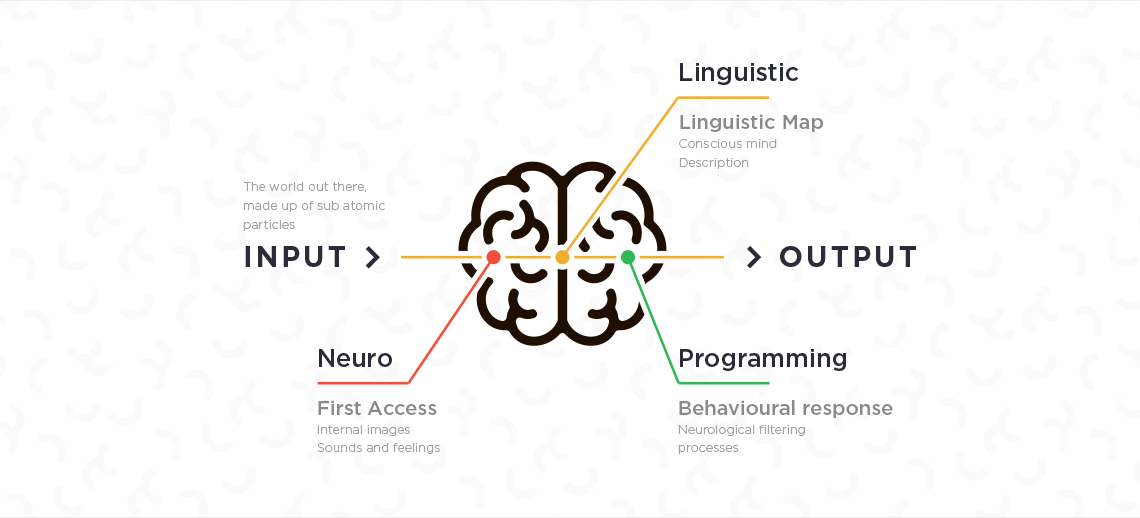Attitudes that Count – Mindsets for Business Success
from:
NLP: The Essential Handbook for Business: Communication Techniques to Build Relationships, Influence Others, and Achieve Your Goals
by Jeremy Lazarus
Nine Presuppositions that are most relevant to the workplace. For your convenience, these have been divided into three groups (please note that these groupings are for guideline purposes and that some could fall into more than one category).
- Externally focused, i.e. based on or impacting on the outside world.
- Internally focused and internal attitudes.
- Results/activity focused.
Externally focused
The meaning and outcome of communication are in the response you get.
Our interpretation of a situation is not the situation itself.
Have respect for other people’s point of view.
Seek first to understand, then be understood.
—Stephen Covey, author of The 7 Habits of Highly Successful People
You will appreciate from the Communication Model that each person is unique, with different values, beliefs, meta-program profiles, and experiences. Though you might not agree with your colleague, supplier, or customer, if you can demonstrate that you respect their point of view, you will be more likely to influence them (see Covey’s quote), and even if they do not come around to your way of thinking on this particular issue, you can agree to disagree and still maintain a healthy working relationship. Conversely, if you do not demonstrate respect, the relationship may be damaged.
The meaning and outcome of communication are in the response you get.
The Communication Model shows that everyone filters information differently. Though your words and actions might seem clear to you, people you interact with at work might interpret them differently from how you intended, and therefore might respond differently from how you expected; that is, their response is based on the meaning they interpret instead of the one you meant.
Therefore, if certain people at work are not responding in the way you expect, instead of expecting them to change, it is easier if you change the way you communicate. Much of this book is focused on how you can be more flexible when communicating.
Our interpretation of a situation is not the situation itself.
The map is not the territory.
—Alfred Korzybski, philosopher and scientist, who developed the theory of general semantics
It is rare for any meeting to take place where everyone agrees with each other, and then all take the actions exactly as everyone at the meeting expects. This is because we all have our own unique interpretation of events, and this interpretation is not the event. Therefore, you will interpret a situation, such as a negotiation, in a different way from someone else, and you might describe it, for example, as a “battle,” whereas for someone else it is just a conversation or an exploration. We all respond to our own map of the event, not to the actual territory. NLP can help you to appreciate other perspectives and ask questions to gain deeper understanding.
Internally focused and internal attitudes
There are three key NLP Presuppositions in this category:
There is no failure, just feedback.
Flexibility goes a long way.
We are, or can learn to be, in charge of our mind and therefore our results.
There is no failure, just feedback.
Failure is only the opportunity to begin again, only this time more wisely.
—Henry Ford, founder of the Ford Motor Company
There are so many examples of successful business people who “failed” before becoming successful that this book could be devoted to just this topic.
Examples include:
Rowland Hussey Macy Sr., the founder of Macy’s department-store chain, who had at least four retail failures.
Thomas Edison, the holder of over 1,000 patents in the U.S. alone, who allegedly made 10,000 attempts before successfully creating the light bulb.
Bill Gates (the founder of Microsoft), who co-ran a business called Traf-O-Data in the 1970s which lost money.
Walt Disney, whose Laugh-O-Gram Films business went bankrupt after around one year’s trading.
The moral is simple. There is no failure, merely feedback that what you have done did not work. Learn from it, retain (or even intensify) your motivation, and move forward. NLP can help you set goals and maintain the motivation to achieve them (see Chapters 4, 8, and 14).
Flexibility goes a long way.
Insanity: doing the same thing over and over again and expecting different results.
—Albert Einstein
Results/activity focused
- People have all the potential that they need to make the changes they want.
- People are making the best choices they believe they have available and are doing the best they can.
- Modeling excellence leads to improved performance.
People have all the potential that they need to make the changes they want.
The past does not equal the future.
—Tony Robbins, motivational speaker, author, and performance coach
Following on from the previous Presupposition, it is useful to consider that each of us has untapped potential. So whether you are thinking about yourself and your own aspirations, or managing staff and their aspirations, recognizing that everyone has abilities to learn, adapt, be motivated, and excel in certain circumstances will help you (and your colleagues) to progress further than if you believe that everyone is limited to their previous results. The key point here is that though not everyone can be the
most successful business person in the world, the past does not equal the future, and NLP has many techniques to help people fulfil their potential and progress further than they otherwise would.
NLP: The Essential Handbook for Business: Communication Techniques to Build Relationships, Influence Others, and Achieve Your Goals
Reprinted for ZU7S5/5831597, American Public University System Red Wheel/Weiser, Jeremy Lazarus (c) 2015, Copying Prohibited
Page 3 of 6

